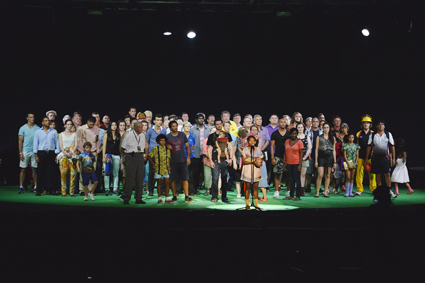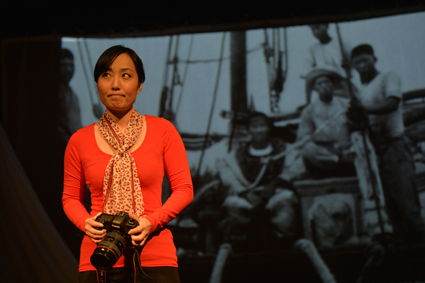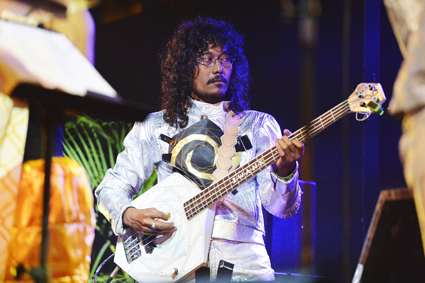Cultural syntheses: north-south, east-west
Nicola Fearn: 2014 Darwin Festival

100% Darwin, Rimini Protokoll, Darwin Festival
Elise Derwin, courtesy Darwin Festival
100% Darwin, Rimini Protokoll, Darwin Festival
Two productions in the 2014 Darwin Festival reviewed here involve distinctive collaborations between Australian and Asian artists, exploring fusions of traditional and contemporary cultural practices. With Asia as northern Australia’s nearest neighbour and being closer to Darwin than other Australian cities, this kind of exchange is becoming more common, with artists engaging in longer-term and ongoing projects. This creative fusion is reflected in the rich mix of ethnicities in the city’s population, as was evident in 100% Darwin.
100% Darwin
Held in the amphitheatre in Darwin’s tropical Botanic Gardens, 100% Darwin is a surprisingly moving, community-building experience. Germany’s Rimini Protokoll have created 100% cities since 2008 starting with Berlin, then 20 other cities around the world. They work with 100 locals with the aim of “performing the diversity” of each city. Casting director Bec Reid selects the first person; in Darwin it was baby Jordan. Each person then has 24 hours to find the next who must fit a specific criterion so that by the 100th person there is a huge cross-section of Darwin’s population represented—diverse ethnicities, ages, political views, sexualities, professions, interests. Ninety percent of the cast members have never been on stage before.
They come one by one onto the slowly revolving stage, each bringing their own special object (equally diverse, from teddy bears to microscopes, photos, tattoos, art and fishing rods). Each introduces themselves with a short snippet: “my vagina was made in Thailand,” and things they love or odd habits they have: “I always put my left shoe on first.” We get to know them and then the statistics begin. Through a series of questions the performance explores who is who, does what and believes what, with people moving to stand beside the “me” and “not me” signs that are held and sometimes dropped if no-one aligns themselves. The performers are supported and guided throughout by live music from local musicians David Spry and The Moral High Ground. It’s surprising and confronting as questions posed move from the easy: “who lives in Palmerston?” to: “who has tried and failed to save a life?” to: “who believes in the death penalty?” and “who has thought about taking their own life?”
This is reality theatre in which Helgard Haug and Daniel Wetzel’s direction ensures the two hours never drag by using different modes of posing and answering the questions that form the core of the piece—participants moving to yes/no areas of the stage, dancing, miming their hourly lives, showing coloured cards, asking questions of each other, asking questions of the audience, shining torches in the dark with birds-eye-view cameras showing results on screens at the sides of the stage. They reveal themselves to the audience and, like reality TV, it is totally absorbing.
Some of the revelations about what people felt shocked me. A large number agreed with the death penalty and would kill for their family and their country. Despite this, a feeling of connection between diverse people was generated and a liking for the very people whose opinions I would strongly oppose.
Book of Shadows: Chapter One
Book of Shadows is an NT/Indonesian collaboration incorporating live actors, traditional Balinese and contemporary shadow puppetry and new media. In a festival usually reserved for completed works it was refreshing to participate in a work-in-progress showing with a discussion and feedback session. It shows the vast amount of work that goes into making such a stylistically complex piece. This work is in its infancy. It has beautiful imagery and depth of combined visuals—kaleidoscopic colour film sequences, animations and elegant shadow puppetry —giving it the visual wow factor although the content still needs clarity and purpose.
Book of Shadows has a plethora of elements and is a deliberate mash-up of multiple Greek and Balinese traditional myths in what is an, as yet, unclear and over-complicated story. Beck Adams’ cave-like set with its scrunched and hanging layers of paper lit in ethereal blue was instantly alluring and provided multiple areas for action and projection. The combination of live and recorded sound moving from electronica to simple thumb piano was evocative, echoing the mix of contemporary and traditional visuals. With strong dramaturgical input this piece could be stunning.

Arisa Yura, Yasukichi Murakami—Through a Distant Lens
Elise Derwin, courtesy Darwin Festival
Arisa Yura, Yasukichi Murakami—Through a Distant Lens
Yasukichi Murakami —Through A Distant Lens
Through a Distant Lens is a delicate and beautifully simple evocation of the life of Yasukichi Murakami, photographer, inventor, entrepreneur and part of Darwin’s high society in the 1930s. The performance begins with the whole end wall of Brown’s Mart theatre covered in a projection of trees moving gently in the breeze and the musician at the side of the stage playing traditional Japanese instruments mixed with recorded sound—wind and birdsong.
Writer Mayu Kanamori, a contemporary Japanese-Australian photographer and performance maker, probes Murakami’s colourful past and searches for truths about his life and his photographs—the latter lost when he was interned as an ‘enemy alien’ in Victoria after the bombing of Darwin in 1942. Diverse story-telling techniques are used to unearth secrets and truths which are based on historical research: direct address, acted scenes, projected still images and interactive film of Murakami’s stern traditional mother played by Yumi Umiumare .The character of Murakami appears as a ghost with camera in hand to talk about life and art with young Mayu. They banter, philosophise, dance together, watch projected images of his family and friends and meditate on the nature of photography. The old sepia photographs of Murakami’s Japanese family tell both his personal story and that of many Japanese Australians of the time. We see the formal family weddings, the Japanese pearl divers’ graveyard in Broome, Captain Gregory the flamboyant pearl lugger owner and friend and business associate of Murakami, Tatura internment camp and Murakami’s own portraits of his children. Finally we see images of his funeral. This is a gently moving production with elements seamlessly combined and supported by a haunting soundtrack and live music. The opening night at Brown’s Mart was especially poignant as the two front rows were filled with Murakami’s descendants. (See also p5.)

The Lepidopters
photo Elise Derwin, courtesy Darwin Festival
The Lepidopters
Lepidopters, A Space Opera, Part Four
Punkasila, Indonesian mystic art music punk band, renowned Australian classical pianist Michael Kieran Harvey, singer-dancer Rachel Saraswati and local Darwin artists and musicians came together to create this behemoth tipped as a “sci-fi-meets-alien-moths-meets-Javanese-mysticism visual/video /musical/installation performance experience.”
An eclectic mix of Gamelan, post-punk, classical/jazz piano and projected illustrations, this space opera is an Australian/Indonesian collaboration that defies definition and challenges audiences—some leaving, some whooping. Silver-suited band Punkasila with big hair and geometric electric guitars (Gary Glitter comes to mind) take centre stage with Harvey on piano and Saraswati combining the traditional and post punk in both her vocals and movement. Divided into movements, this production is a roller coaster of confusion and entertainment, opening with Harvey’s looped jazz piano, followed by the Darwin Gamelan Orchestra and Choir, then a punk band, live piano and flute with traditional Indonesian backing, a guitar and synth duet and even local Indigenous performer June Mills performing a Larrakia welcome to country with acoustic guitar. The projected animations continued throughout all the musical sections with hand-drawn images telling the story of the alien moth invasion, its meaning not clear to all—but that was immaterial as the performers took the willing on a journey and left others to fend for themselves.
Darwin Festival, 100% Darwin, concept, direction, dramaturgy Rimini Protokoll, Darwin, The Amphitheatre, George’s Green, 9 Aug; Book of Shadows: Chapter One, Brown’s Mart Theatre, 10 Aug; Yasukichi Murakami—Through A Distant Lens, writer, creator Mayu Kanamori, dramaturg Jane Bodie, director Malcolm Blaylock, Brown’s Mart Theatre, 19, 20 Aug; Lepidopters, A Space Opera, Part Four, creator, musician Danius Kesminas, visuals Erwan ‘Iwank,’ Hersi Susanto, Terra Bajraghosa, Slave Pianos, The Lighthouse, Darwin, 7-24 August
RealTime issue #123 Oct-Nov 2014 pg. 6






